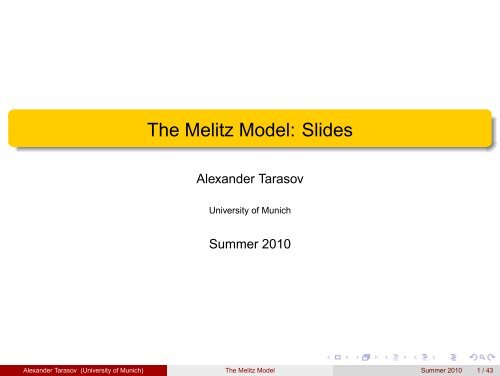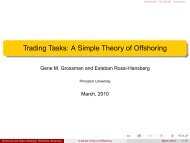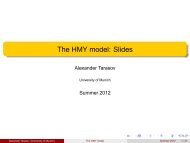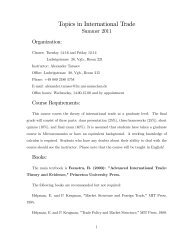The Melitz Model: Slides
The Melitz Model: Slides
The Melitz Model: Slides
Create successful ePaper yourself
Turn your PDF publications into a flip-book with our unique Google optimized e-Paper software.
<strong>The</strong> <strong>Melitz</strong> <strong>Model</strong>: <strong>Slides</strong><br />
Alexander Tarasov<br />
University of Munich<br />
Summer 2010<br />
Alexander Tarasov (University of Munich) <strong>The</strong> <strong>Melitz</strong> <strong>Model</strong> Summer 2010 1 / 43
Empirical Evidence<br />
BEJK (2003)<br />
Exporters are in the minority. In 1992, only 21% of U.S. plants reported<br />
exporting anything.<br />
Exporters sell most of their output domestically: around 2/3 of exporters sell<br />
less than 10% of their output abroad.<br />
Exporters are bigger than non-exporters: they ship on average 5.6 times<br />
more than nonexporters (4.8 times more domestically).<br />
Plants are also heterogeneous in measured productivity.<br />
exporters have, on average, a 33% advantage in labor productivity relative to<br />
nonexporters<br />
This suggests that the most productive rms self-select into export markets, but it<br />
could also reect learning by exporting.<br />
Alexander Tarasov (University of Munich) <strong>The</strong> <strong>Melitz</strong> <strong>Model</strong> Summer 2010 2 / 43
Empirical Evidence<br />
<strong>The</strong>re are substantial reallocation effects within an industry following trade<br />
liberalization episodes.<br />
Exposure to trade forces the least productive rms to exit or shut-down (Bernard<br />
and Jensen (1999), Aw et al. (2000), Clerides et al. (1998)).<br />
Trade liberalization leads to market share reallocations towards more productive<br />
rms, thereby increasing aggregate productivity (Pavcnik (2002), Bernard and<br />
Jensen (1999b)).<br />
<strong>The</strong>oretical frameworks for studying rms and the decision to export should<br />
include two features:<br />
within sectoral heterogeneity in size and productivity<br />
a feature that leads only the most productive rms to engage in foreign trade<br />
Alexander Tarasov (University of Munich) <strong>The</strong> <strong>Melitz</strong> <strong>Model</strong> Summer 2010 3 / 43
Motivation of <strong>Melitz</strong> (2003)<br />
<strong>Melitz</strong> (2003) develops a highly tractable framework that captures the empirical<br />
evidence.<br />
Notice! <strong>The</strong> Krugman model is not able to explain the evidence discussed above.<br />
In the model, all rms are identical and export to all possible destinations.<br />
Alexander Tarasov (University of Munich) <strong>The</strong> <strong>Melitz</strong> <strong>Model</strong> Summer 2010 4 / 43
Key Features<br />
<strong>The</strong> Krugman model (with monopolistic competition and increasing returns)<br />
with heterogenous rms.<br />
Variable and xed costs of trade.<br />
BEJK (2003) develops another approach based on the Ricardian model of<br />
trade that is also able to capture the evidence!<br />
xed (exogenous) number of varieties: competition between domestic and<br />
foreign producers of the same variety<br />
endogenous markups<br />
Alexander Tarasov (University of Munich) <strong>The</strong> <strong>Melitz</strong> <strong>Model</strong> Summer 2010 5 / 43
<strong>Model</strong>: Closed Economy<br />
Demand<br />
A CES utility function over a continuum of goods indexed by ω:<br />
Q =<br />
Z 1/ρ<br />
q(ω) ρ dω<br />
ω2Ω<br />
where Ω is the set of available goods and ρ 2 (0, 1). <strong>The</strong> elasticity of<br />
substitution between two goods is<br />
Demand for a certain variety:<br />
σ = 1<br />
1 ρ () ρ = σ 1<br />
σ .<br />
p(ω) σ<br />
q(ω) = Q<br />
.<br />
P<br />
Alexander Tarasov (University of Munich) <strong>The</strong> <strong>Melitz</strong> <strong>Model</strong> Summer 2010 6 / 43
<strong>Model</strong>: Closed Economy<br />
Demand<br />
<strong>The</strong> CES price index:<br />
P =<br />
Z<br />
p(ω) 1<br />
ω2Ω<br />
1<br />
σ 1 σ<br />
dω<br />
Expenditure on a variety ω:<br />
p(ω) 1 σ<br />
r(ω) = p(ω)q(ω) = R<br />
,<br />
P<br />
where R = PQ = R ω2Ω<br />
r(ω)dω is aggregate expenditure.<br />
Alexander Tarasov (University of Munich) <strong>The</strong> <strong>Melitz</strong> <strong>Model</strong> Summer 2010 7 / 43
<strong>Model</strong>: Closed Economy<br />
Production<br />
Continuum of rms<br />
Labor is the only factor of production: L<br />
Total costs:<br />
l = f + q/ϕ<br />
where ϕ is a rm specic productivity and q is the output.<br />
Given the demand function:<br />
p(ϕ) = w ρϕ<br />
where w is the wage rate, which is normalized to unity: w = 1.<br />
Alexander Tarasov (University of Munich) <strong>The</strong> <strong>Melitz</strong> <strong>Model</strong> Summer 2010 8 / 43
<strong>Model</strong>: Closed Economy<br />
Production<br />
Firm prot is given by<br />
π(ϕ) = R σ (Pρϕ)σ 1 f<br />
Revenues:<br />
r(ϕ) = p(ϕ)q(ϕ) = R (Pρϕ) σ 1 .<br />
Notice that<br />
π(ϕ) = r(ϕ)<br />
σ<br />
f .<br />
Alexander Tarasov (University of Munich) <strong>The</strong> <strong>Melitz</strong> <strong>Model</strong> Summer 2010 9 / 43
<strong>Model</strong>: Closed Economy<br />
Production<br />
Finally, for any ϕ 1<br />
and ϕ 2<br />
,<br />
r(ϕ 1<br />
)<br />
r(ϕ 2<br />
) = <br />
ϕ1<br />
ϕ 2<br />
σ 1<br />
.<br />
In summary, a more productive rm will be bigger (larger output and<br />
revenues), charge a lower price, and earn higher prots than a less<br />
productive rm.<br />
Alexander Tarasov (University of Munich) <strong>The</strong> <strong>Melitz</strong> <strong>Model</strong> Summer 2010 10 / 43
<strong>Model</strong>: Closed Economy<br />
Aggregation<br />
An equilibrium is characterized by a mass M of rms (and hence M goods)<br />
and a distribution µ(ϕ) of productivity levels over a subset of (0, ∞).<br />
You can think that there are Mµ(ϕ) rms with productivity ϕ.<br />
<strong>The</strong>n, the price index<br />
P =<br />
=<br />
Z ∞<br />
p(ϕ) 1<br />
0<br />
" Z ∞<br />
0<br />
= M 1<br />
1 σ<br />
1<br />
σ 1 σ<br />
Mµ(ϕ)d ϕ<br />
1<br />
1 σ 1 σ<br />
1<br />
Mµ(ϕ)d ϕ#<br />
ρϕ<br />
1<br />
ρ R ∞<br />
0 ϕσ 1 µ(ϕ)d ϕ 1<br />
σ 1<br />
.<br />
Alexander Tarasov (University of Munich) <strong>The</strong> <strong>Melitz</strong> <strong>Model</strong> Summer 2010 11 / 43
<strong>Model</strong>: Closed Economy<br />
Aggregation<br />
Let us dene<br />
Z ∞<br />
˜ϕ =<br />
0<br />
ϕ σ<br />
1<br />
1 σ 1<br />
µ(ϕ)d ϕ<br />
as a weighted average of the rm productivities.<br />
<strong>The</strong>n,<br />
P = M 1<br />
1 σ p( ˜ϕ)<br />
Q = M 1/ρ q( ˜ϕ)<br />
Alexander Tarasov (University of Munich) <strong>The</strong> <strong>Melitz</strong> <strong>Model</strong> Summer 2010 12 / 43
<strong>Model</strong>: Closed Economy<br />
Aggregation<br />
Moreover,<br />
R = PQ = Mp( ˜ϕ)q( ˜ϕ) = Mr( ˜ϕ)<br />
Π = Mπ( ˜ϕ)<br />
where Π = R ∞<br />
π(ϕ)Mµ(ϕ)d ϕ is total prots.<br />
0<br />
An industry comprised of M rms with any distribution of productivity levels<br />
µ(ϕ) that yields the same average productivity ˜ϕ will also induce the same<br />
aggregate outcome as an industry with M representative rms sharing the<br />
same productivity ϕ = ˜ϕ (the Krugman model).<br />
Alexander Tarasov (University of Munich) <strong>The</strong> <strong>Melitz</strong> <strong>Model</strong> Summer 2010 13 / 43
<strong>Model</strong>: Closed Economy<br />
Firm Entry and Exit<br />
<strong>The</strong>re is a large (unbounded) pool of prospective entrants into the industry.<br />
To enter, rms must make an initial investment modeled as a xed entry cost<br />
f e > 0 (measured in labor units).<br />
Firms then draw their initial productivity parameter ϕ from a common<br />
distribution g(ϕ) with the support on [0, ∞).<br />
Conditional on the productivity drawn, rms decided whether to stay and<br />
produce or to exit and not produce.<br />
If the rm does produce, it then faces a constant probability δ in every period<br />
of a bad shock that would force it to exit.<br />
We consider only steady state equilibria in which aggregate variables remain<br />
constant over time.<br />
Alexander Tarasov (University of Munich) <strong>The</strong> <strong>Melitz</strong> <strong>Model</strong> Summer 2010 14 / 43
<strong>Model</strong>: Closed Economy<br />
Firm Entry and Exit<br />
Each rm's value function is given by<br />
v(ϕ) = max(0,<br />
∞<br />
∑<br />
t=0<br />
= max(0, π(ϕ) ).<br />
δ<br />
Notice that ϕ does not change over time.<br />
(1 δ) t π(ϕ))<br />
Dene ϕ as the cutoff level of productivity. That is, rms with ϕ < ϕ exit<br />
and do not produce. <strong>The</strong>n,<br />
ϕ = inf (ϕ : v(ϕ) > 0) .<br />
<strong>The</strong> zero prot condition:<br />
π(ϕ ) = 0.<br />
Alexander Tarasov (University of Munich) <strong>The</strong> <strong>Melitz</strong> <strong>Model</strong> Summer 2010 15 / 43
<strong>Model</strong>: Closed Economy<br />
Firm Entry and Exit<br />
<strong>The</strong>refore, µ(ϕ) is the conditional distribution of g(ϕ) on [ϕ , ∞) :<br />
8<br />
< g(ϕ)<br />
1 G(ϕ<br />
µ(ϕ) =<br />
, if ϕ ϕ<br />
)<br />
: 0, otherwise,<br />
and p in = 1<br />
<strong>The</strong>refore,<br />
G(ϕ ) is the probability of successful entry.<br />
<br />
˜ϕ = ˜ϕ(ϕ 1<br />
) =<br />
1 G(ϕ )<br />
Z ∞<br />
ϕ ϕσ 1 g(ϕ)d ϕ<br />
1<br />
σ 1<br />
.<br />
Alexander Tarasov (University of Munich) <strong>The</strong> <strong>Melitz</strong> <strong>Model</strong> Summer 2010 16 / 43
<strong>Model</strong>: Closed Economy<br />
Zero Cutoff Prot Condition<br />
Let us denote ¯r as average revenues (revenues per rm), then<br />
¯r = R M<br />
= r( ˜ϕ).<br />
Moreover, we have<br />
Hence,<br />
r( ˜ϕ)<br />
r(ϕ ) = ˜ϕ<br />
ϕ σ 1<br />
.<br />
¯r =<br />
˜ϕ(ϕ )<br />
ϕ σ 1<br />
r(ϕ ).<br />
Alexander Tarasov (University of Munich) <strong>The</strong> <strong>Melitz</strong> <strong>Model</strong> Summer 2010 17 / 43
<strong>Model</strong>: Closed Economy<br />
Zero Cutoff Prot Condition<br />
In the same manner, ¯π is denoted as average prots (prots per rm). That<br />
is,<br />
Thus, we obtain that<br />
¯π = Π M<br />
= π( ˜ϕ) =<br />
r( ˜ϕ)<br />
σ<br />
f<br />
¯π =<br />
˜ϕ(ϕ )<br />
σ 1 r(ϕ )<br />
ϕ σ<br />
f .<br />
Alexander Tarasov (University of Munich) <strong>The</strong> <strong>Melitz</strong> <strong>Model</strong> Summer 2010 18 / 43
<strong>Model</strong>: Closed Economy<br />
Zero Cutoff Prot Condition<br />
<strong>The</strong> zero prot condition means that<br />
π(ϕ ) = r(ϕ )<br />
σ<br />
r(ϕ ) = σf .<br />
f = 0 ()<br />
<strong>The</strong>refore,<br />
˜ϕ(ϕ<br />
¯π =<br />
<br />
) σ 1 r(ϕ )<br />
ϕ f<br />
σ<br />
˜ϕ(ϕ<br />
=<br />
<br />
) σ 1<br />
σf<br />
ϕ f<br />
σ<br />
˜ϕ(ϕ<br />
= !<br />
) σ 1<br />
f<br />
ϕ 1 .<br />
Alexander Tarasov (University of Munich) <strong>The</strong> <strong>Melitz</strong> <strong>Model</strong> Summer 2010 19 / 43
<strong>Model</strong>: Closed Economy<br />
Free Entry<br />
<strong>The</strong> net value of entry:<br />
v e = (1 G(ϕ ))<br />
∞<br />
∑<br />
t=0<br />
(1 δ) t ¯π f e<br />
= (1 G(ϕ )) ¯π δ<br />
f e<br />
Free entry implies that<br />
v e = 0 ()<br />
¯π =<br />
δf e<br />
1 G(ϕ ) .<br />
Alexander Tarasov (University of Munich) <strong>The</strong> <strong>Melitz</strong> <strong>Model</strong> Summer 2010 20 / 43
<strong>Model</strong>: Closed Economy<br />
Equilibrium<br />
We have<br />
¯π = f<br />
˜ϕ(ϕ !<br />
) σ 1<br />
ϕ 1<br />
¯π =<br />
δf e<br />
1 G(ϕ ) .<br />
So, there are two equations and two unknowns and we can solve for ϕ and<br />
¯π.<br />
If we know ϕ , we can nd ˜ϕ, as ˜ϕ = ˜ϕ(ϕ ).<br />
Alexander Tarasov (University of Munich) <strong>The</strong> <strong>Melitz</strong> <strong>Model</strong> Summer 2010 21 / 43
<strong>Model</strong>: Closed Economy<br />
Equilibrium: Mass of Firms<br />
Let us denote M e as the mass of entrants in each period.<br />
In steady state:<br />
(1 G(ϕ )) M e = δM.<br />
Labor market clearing condition:<br />
L = L p + L e<br />
where L p is labor used in production and L e is labor used to enter the<br />
industry.<br />
Moreover,<br />
L p = R Π.<br />
Alexander Tarasov (University of Munich) <strong>The</strong> <strong>Melitz</strong> <strong>Model</strong> Summer 2010 22 / 43
<strong>Model</strong>: Closed Economy<br />
Equilibrium: Mass of Firms<br />
Finally,<br />
<strong>The</strong>refore,<br />
In addition,<br />
L e = M e f e =<br />
L e = M e f e .<br />
δM<br />
1 G(ϕ ) f e = M ¯π = Π<br />
R = L p + Π = L p + L e = L.<br />
Alexander Tarasov (University of Munich) <strong>The</strong> <strong>Melitz</strong> <strong>Model</strong> Summer 2010 23 / 43
<strong>Model</strong>: Closed Economy<br />
Equilibrium: Mass of Firms<br />
Hence,<br />
R = L<br />
M = R¯r<br />
=<br />
L<br />
σ( ¯π + f ) .<br />
Finally, the price index is given by<br />
P = M 1<br />
1 σ p( ˜ϕ) = M 1<br />
1 σ 1<br />
ρ ˜ϕ .<br />
Alexander Tarasov (University of Munich) <strong>The</strong> <strong>Melitz</strong> <strong>Model</strong> Summer 2010 24 / 43
<strong>Model</strong>: Closed Economy<br />
Analysis of the Equilibrium<br />
Notice that all the rm-level variables (ϕ , ˜ϕ, ¯π, and ¯r) do no depend on the<br />
country size L.<br />
Welfare per worker:<br />
W = w P = M σ<br />
1<br />
1 ρ ˜ϕ.<br />
So, we have the variety effect (through M) and the productivity effect (through<br />
˜ϕ).<br />
Welfare in a larger country is higher due to only the variety effect (a la<br />
Krugman (1980)).<br />
Note that in Krugman (1980), we can derive a similar expression for welfare,<br />
if all rms have productivity ˜ϕ. However, in the Krugman model, ˜ϕ would be<br />
exogenous and is not affected by trade. In this model, ˜ϕ is an endogenous<br />
variable and is affected by trade.<br />
Alexander Tarasov (University of Munich) <strong>The</strong> <strong>Melitz</strong> <strong>Model</strong> Summer 2010 25 / 43
<strong>Model</strong>: Open Economy<br />
If there are no trade costs, then trade allows the individual countries to<br />
replicate the outcome of the integrated world equilibrium. It is equivalent to a<br />
rise in a country size L. In this case, there is no effect on the rm-level<br />
variables and welfare increases because of the variety effect. <strong>The</strong> same<br />
result can be derived in the Krugman model.<br />
In the model, there are both variable (iceberg) and xed costs of trade. Fixed<br />
costs should be paid after the realization of productivity. That is, rms know ϕ<br />
and then decide whether to export or not.<br />
n + 1 identical countries. <strong>The</strong>refore, the wage is the same in all countries<br />
(FPE) and is normalized to unity.<br />
Alexander Tarasov (University of Munich) <strong>The</strong> <strong>Melitz</strong> <strong>Model</strong> Summer 2010 26 / 43
<strong>Model</strong>: Open Economy<br />
Pricing Rule<br />
<strong>The</strong> domestic (producer) price is<br />
<strong>The</strong> export price is given by<br />
where τ is the Iceberg transport costs.<br />
p d (ϕ) = 1<br />
ρϕ .<br />
p x (ϕ) = τp d (ϕ) = τ<br />
ρϕ<br />
Alexander Tarasov (University of Munich) <strong>The</strong> <strong>Melitz</strong> <strong>Model</strong> Summer 2010 27 / 43
<strong>Model</strong>: Open Economy<br />
Revenues<br />
<strong>The</strong> revenues earned from domestic sales are given by<br />
r d (ϕ) = R (Pρϕ) σ 1<br />
Revenues from export sales:<br />
r x (ϕ) =<br />
<br />
R P ρϕ σ 1<br />
τ<br />
= τ 1 σ R (Pρϕ) σ 1<br />
= τ 1 σ r d (ϕ).<br />
<strong>The</strong> total revenues depend on the export status:<br />
8<br />
< r d (ϕ), if the rm does not export<br />
r(ϕ) =<br />
: r d (ϕ) + nr x (ϕ), if the rm exports.<br />
Alexander Tarasov (University of Munich) <strong>The</strong> <strong>Melitz</strong> <strong>Model</strong> Summer 2010 28 / 43
<strong>Model</strong>: Open Economy<br />
Entry, Exit, and Export Status<br />
<strong>The</strong> export cost are equal across countries<br />
a rm either exports in every period to all destinations or never export<br />
Export decision occurs after rms know their productivity ϕ: f x is per period<br />
(per country) xed costs of trade.<br />
<strong>The</strong>refore,<br />
π d (ϕ) = r d (ϕ)<br />
σ<br />
π x (ϕ) = r x (ϕ)<br />
σ<br />
f<br />
f x<br />
Total prots:<br />
π(ϕ) = π d (ϕ) + max (0, nπ x (ϕ)) .<br />
Alexander Tarasov (University of Munich) <strong>The</strong> <strong>Melitz</strong> <strong>Model</strong> Summer 2010 29 / 43
<strong>Model</strong>: Open Economy<br />
Entry, Exit, and Export Status<br />
By analogy with the closed economy, the rm value is given by<br />
<br />
v(ϕ) = max 0, π(ϕ) <br />
δ<br />
<strong>The</strong> domestic cutoff:<br />
ϕ = inf (ϕ : v(ϕ) > 0)<br />
<strong>The</strong> exporting cutoff:<br />
ϕ x = inf (ϕ : ϕ ϕ and π x (ϕ) > 0)<br />
Alexander Tarasov (University of Munich) <strong>The</strong> <strong>Melitz</strong> <strong>Model</strong> Summer 2010 30 / 43
<strong>Model</strong>: Open Economy<br />
Entry, Exit, and Export Status<br />
If for instance ϕ = ϕ x<br />
, then all rms in the industry export, then the cutoff<br />
ϕ solves<br />
π(ϕ ) = π d (ϕ ) + nπ x (ϕ ) = 0<br />
If ϕ x > ϕ , then some rms produce only for their domestic market. Those<br />
rms do not export because of negative exporting prots. In this case,<br />
π d (ϕ ) = 0<br />
π x (ϕ x ) = 0.<br />
Notice that it cannot be the case ϕ x < ϕ !!!<br />
Alexander Tarasov (University of Munich) <strong>The</strong> <strong>Melitz</strong> <strong>Model</strong> Summer 2010 31 / 43
<strong>Model</strong>: Open Economy<br />
Entry, Exit, and Export Status<br />
ϕ x > ϕ if and only if τ σ<br />
1 f x > f (this is our assumption).<br />
<strong>The</strong> distribution of productivities µ(ϕ) is the same as before. Namely,<br />
8<br />
< g(ϕ)<br />
1 G(ϕ<br />
µ(ϕ) =<br />
, if ϕ ϕ<br />
)<br />
: 0, otherwise.<br />
<strong>The</strong> probability of successful entry is<br />
p in = 1 G(ϕ ).<br />
<strong>The</strong> probability of exporting (conditional on successful entry):<br />
p x = 1 G(ϕ x )<br />
1 G(ϕ ) .<br />
Alexander Tarasov (University of Munich) <strong>The</strong> <strong>Melitz</strong> <strong>Model</strong> Summer 2010 32 / 43
<strong>Model</strong>: Open Economy<br />
Entry, Exit, and Export Status<br />
Let M denote the equilibrium mass of rms, then<br />
M x = p x M<br />
is the mass of exporting rms.<br />
<strong>The</strong>refore,<br />
M t = M + nM x<br />
represents the total mass of varieties in any country.<br />
Alexander Tarasov (University of Munich) <strong>The</strong> <strong>Melitz</strong> <strong>Model</strong> Summer 2010 33 / 43
<strong>Model</strong>: Open Economy<br />
Aggregation<br />
It can be shown (see the class note) that<br />
where<br />
˜ϕ t<br />
=<br />
P = M<br />
1<br />
1 σ<br />
t<br />
p( ˜ϕ t<br />
) = M<br />
1<br />
1 σ<br />
t<br />
1<br />
ρ ˜ϕ t<br />
,<br />
1<br />
M t<br />
M ( ˜ϕ(ϕ )) σ 1 + nM x<br />
τ 1 ˜ϕ(ϕ x ) σ 1<br />
1<br />
σ 1<br />
is the weighted average productivity of all rms competing in a single market.<br />
˜ϕ t<br />
is the analogue of ˜ϕ in the closed economy.<br />
Alexander Tarasov (University of Munich) <strong>The</strong> <strong>Melitz</strong> <strong>Model</strong> Summer 2010 34 / 43
<strong>Model</strong>: Open Economy<br />
Aggregation<br />
Furthermore (see the class note),<br />
R = M t r d ( ˜ϕ t<br />
)<br />
Finally, average revenues are given by<br />
¯r = R M = r d ( ˜ϕ(ϕ )) + np x r x ( ˜ϕ(ϕ x ))<br />
While average prots<br />
¯π = π d ( ˜ϕ(ϕ )) + np x π x ( ˜ϕ(ϕ x ))<br />
Alexander Tarasov (University of Munich) <strong>The</strong> <strong>Melitz</strong> <strong>Model</strong> Summer 2010 35 / 43
<strong>Model</strong>: Open Economy<br />
Equilibrium Conditions<br />
<strong>The</strong> zero prot conditions imply that<br />
π d (ϕ ) = 0 () π d ( ˜ϕ(ϕ )) = f<br />
π x (ϕ x ) = 0 () π x ( ˜ϕ(ϕ x )) = f x<br />
˜ϕ(ϕ !<br />
) σ 1<br />
ϕ 1<br />
˜ϕ(ϕ<br />
<br />
<br />
x<br />
) σ 1<br />
1!<br />
ϕ x<br />
This implies that<br />
¯π = f<br />
˜ϕ(ϕ !<br />
) σ 1<br />
ϕ 1<br />
˜ϕ(ϕ<br />
<br />
<br />
+ np x f x<br />
) σ 1<br />
x 1!<br />
ϕx<br />
<br />
Alexander Tarasov (University of Munich) <strong>The</strong> <strong>Melitz</strong> <strong>Model</strong> Summer 2010 36 / 43
<strong>Model</strong>: Open Economy<br />
Equilibrium Conditions<br />
Finally,<br />
That is,<br />
r x (ϕ x )<br />
r d (ϕ ) = f x<br />
f<br />
ϕ x = τϕ <br />
fx<br />
f<br />
= τ 1 σ ϕ<br />
<br />
x<br />
ϕ σ 1<br />
.<br />
1<br />
σ 1<br />
.<br />
Alexander Tarasov (University of Munich) <strong>The</strong> <strong>Melitz</strong> <strong>Model</strong> Summer 2010 37 / 43
<strong>Model</strong>: Open Economy<br />
Equilibrium Conditions<br />
<strong>The</strong> free entry condition remains unchanged<br />
¯π = δf e<br />
p in<br />
In addition,<br />
¯π = f<br />
˜ϕ(ϕ !<br />
) σ 1<br />
ϕ 1<br />
˜ϕ(ϕ<br />
<br />
<br />
+ np x f x<br />
) σ 1<br />
x 1!<br />
ϕx<br />
<br />
ϕ x<br />
= τϕ <br />
fx<br />
f<br />
1<br />
σ 1<br />
.<br />
<strong>The</strong> can solve for ϕ and ¯π.<br />
Alexander Tarasov (University of Munich) <strong>The</strong> <strong>Melitz</strong> <strong>Model</strong> Summer 2010 38 / 43
<strong>Model</strong>: Open Economy<br />
Equilibrium Conditions<br />
If we know ϕ , we can nd ϕ x , ˜ϕ t , ˜ϕ(ϕ ), ˜ϕ(ϕ x ), p in, and p x .<br />
Along the steady state:<br />
This means that<br />
p in M e = δM<br />
R = L<br />
Finally, the mass of rms<br />
M = R¯r<br />
=<br />
L<br />
σ ( ¯π + f + p x nf x ) .<br />
Alexander Tarasov (University of Munich) <strong>The</strong> <strong>Melitz</strong> <strong>Model</strong> Summer 2010 39 / 43
<strong>Model</strong>: Open Economy<br />
<strong>The</strong> Impact of Trade<br />
Let us denote ϕ a<br />
as the cutoff in autarky, then from the picture in the class, it<br />
can be seen that<br />
ϕ > ϕ a<br />
<strong>The</strong> least productive rms with ϕ 2 (ϕ a , ϕ ) no longer earn positive prots<br />
and, thereby, exit. It is consistent with the literature.<br />
the reallocation of resources towards more productive rms<br />
Notice also that ¯π > ¯π a , which implies that M < M a and the number of<br />
domestic producers will fall. However, as long as τ is not too high,<br />
M t = (1 + np x )M > M a .<br />
Alexander Tarasov (University of Munich) <strong>The</strong> <strong>Melitz</strong> <strong>Model</strong> Summer 2010 40 / 43
<strong>Model</strong>: Open Economy<br />
<strong>The</strong> Impact of Trade<br />
Intuition:<br />
<strong>The</strong> elasticity of demand is unaffected by trade opening, so the fall in prot for<br />
domestic producers is not explained by a fall in mark-ups driven by increased<br />
foreign competition.<br />
<strong>The</strong> actual channel operates through the domestic factor market. In<br />
particular, trade translates into increased protable opportunities for rms<br />
(recall that ¯π goes up). This translates into more entry, thereby increasing<br />
labor demand and (given the xed supply of labor) leading to a rise in the real<br />
wage w P<br />
. This, in turn, brings down the prot level of the least productive<br />
rms to a level that forces them to exit.<br />
Alexander Tarasov (University of Munich) <strong>The</strong> <strong>Melitz</strong> <strong>Model</strong> Summer 2010 41 / 43
<strong>Model</strong>: Open Economy<br />
<strong>The</strong> Impact of Trade<br />
Welfare in autarky is given by<br />
W a = M<br />
1<br />
σ 1<br />
a<br />
ρ ˜ϕ (ϕ a ) = ρ L<br />
σf<br />
1<br />
σ 1<br />
ϕ<br />
<br />
a<br />
Similarly,<br />
W = ρ<br />
1<br />
L σ 1<br />
ϕ<br />
<br />
σf<br />
Since ϕ > ϕ a , W > W a. <strong>The</strong>re are gains from trade.<br />
Alexander Tarasov (University of Munich) <strong>The</strong> <strong>Melitz</strong> <strong>Model</strong> Summer 2010 42 / 43
<strong>Model</strong>: Open Economy<br />
<strong>The</strong> Impact of Trade<br />
Finally, we are interested in showing that the model can replicate the type of<br />
market shares reallocations found in the data. In particular, it is possible to<br />
show<br />
r d (ϕ) < r a (ϕ) < r d (ϕ) + nr x (ϕ) for any ϕ ϕ <br />
<strong>The</strong> rst part of the inequality implies that all rms incur a loss in domestic<br />
sales in the open economy.<br />
<strong>The</strong> second part shows that an exporting rm has higher total revenues: a<br />
decrease in domestic sales is compensated by a rise in exports.<br />
<strong>The</strong>refore, a rm who exports increase its share of industry revenues while a<br />
rm who does not export loses market share: redistribution (consistent with<br />
the data).<br />
Alexander Tarasov (University of Munich) <strong>The</strong> <strong>Melitz</strong> <strong>Model</strong> Summer 2010 43 / 43







